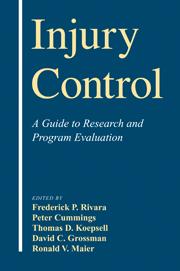Book contents
- Frontmatter
- Contents
- List of Contributors
- 1 An Overview of Injury Research
- 2 Classifying and Counting Injury
- 3 Measurement of Injury Severity and Co-morbidity
- 4 Data Linkages and Using Administrative and Secondary Databases
- 5 Rates, Rate Denominators, and Rate Comparisons
- 6 Data Collection Methods
- 7 Selecting a Study Design for Injury Research
- 8 Qualitative Methods in Injury Research
- 9 Randomized Trials
- 10 Cohort Studies in Injury Research
- 11 Case–Control Studies in Injury Research
- 12 Ecologic Studies
- 13 Case Series and Trauma Registries
- 14 Systematic Reviews of Injury Studies
- 15 Evaluating an Injury Intervention or Program
- 16 The Development of Clinical Decision Rules for Injury Care
- 17 Trauma Performance Improvement
- 18 Measuring Disability and Quality of Life Postinjury
- 19 Economic Evaluation of Injury Control
- 20 Ethical Issues
- Index
12 - Ecologic Studies
Published online by Cambridge University Press: 16 October 2009
- Frontmatter
- Contents
- List of Contributors
- 1 An Overview of Injury Research
- 2 Classifying and Counting Injury
- 3 Measurement of Injury Severity and Co-morbidity
- 4 Data Linkages and Using Administrative and Secondary Databases
- 5 Rates, Rate Denominators, and Rate Comparisons
- 6 Data Collection Methods
- 7 Selecting a Study Design for Injury Research
- 8 Qualitative Methods in Injury Research
- 9 Randomized Trials
- 10 Cohort Studies in Injury Research
- 11 Case–Control Studies in Injury Research
- 12 Ecologic Studies
- 13 Case Series and Trauma Registries
- 14 Systematic Reviews of Injury Studies
- 15 Evaluating an Injury Intervention or Program
- 16 The Development of Clinical Decision Rules for Injury Care
- 17 Trauma Performance Improvement
- 18 Measuring Disability and Quality of Life Postinjury
- 19 Economic Evaluation of Injury Control
- 20 Ethical Issues
- Index
Summary
Introduction
Ecologic studies are investigations in which groups, rather than individuals, are the units of analysis (Morgenstern, 1995). Typically, the groups under study are the resident populations of geopolitical areas such as states, counties, or census tracts; but in principle, studies of other kinds of groups, such as students in certain schools or employees in certain workplaces, would also qualify as ecologic. Studies that involve random assignment of social groups en bloc to alternative conditions also fit our definition of ecologic studies, but for convenience we consider them to be a special kind of randomized trial, as discussed in Chapter 9; here, we consider only observational ecologic studies. Morgenstern (1982, 1995, 1998) has written useful reviews of the ecologic study design.
As an introductory example, Anderson et al. (1998) studied neighborhood environmental factors in relation to the incidence of injuries resulting in hospitalization or death among Hispanic and non-Hispanic white children in Orange Country, California. During 1991–92, injury surveillance was conducted at eight local hospitals and in the county coroner's office. Child injuries by age and ethnicity were counted for each of 594 census blockgroups, which ranged from three to 20 city blocks in size. The estimated number of children at risk and certain socio-demographic characteristics of each blockgroup, including household crowding and the proportion of families with income below the federal poverty level, were obtained from the U.S. census data.
Keywords
- Type
- Chapter
- Information
- Injury ControlA Guide to Research and Program Evaluation, pp. 157 - 167Publisher: Cambridge University PressPrint publication year: 2000
- 2
- Cited by

